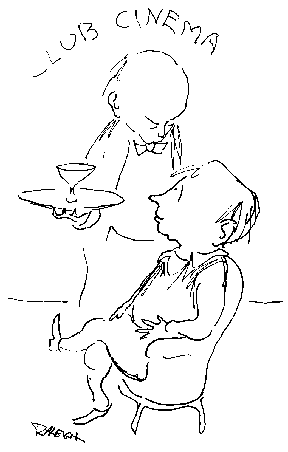 |
Exodus
By Henry P.
Raleigh
ART
TIMES April 2006
Everybody knows it now – movie attendance has been dropping off
for the past several years. Depending on who you listen to, seventeen
or maybe twenty percent fewer people are reaching for ten bucks or so
to see a film. And it’s getting worse with no end in sight. This might
remind some of you of a similar crisis Hollywood faced in the late 40’s
and early 50’s. Then the film audience was deserting the theaters to sit
mesmerized before those porthole shaped screens on their newly acquired
television sets.
Those were fun days; every TV owner became what the
French call a bricoleur, a puttering handy-man endlessly adjusting the
horizontal and vertical controls, fiddling with the fuzzy black and white
images, twisting the life out of rabbit ears, enhancing reception with
coat hangers wrapped in foil, and when all else failed pulling off the
back of the set to yank out likely looking vacuum tubes (there were a
lot of them, too) to check out on the test machine in a local hardware
store. Today we would call this an interactive media experience. After
all, what can you do in a movie house except sit still? Those first television
shows were certainly no better than the available film fare, most a good
deal worse – yet it was hard to beat the widely supposed belief
that the color red didn’t register on the screen. If Fran, of the children’s
show, Kukla, Fran and Ollie, should absently mindedly war a red dress
– well, you see what I mean.
Hollywood responded to the attack by desperately hoping
to drag its missing audience back with silly and short-lived gimmicks:
3-D films, Smell-O-Rama, Sensoround, Cinerama – only a wide-screen
compromise would last out these futile efforts. Movie attendance averaged
90 million weekly in 1946 – by the end of the 50’s it had dropped
to 46 million. In sulky pique the studios had even refused to release
films from their libraries for TV runs. British studios didn’t mind however
and there was a time when during those dead, commercial hours before the
late afternoon kiddie shows came on that you could be treated to even
deadlier English films.
But by the end of the 1940’s a filmic door had been
opened for a new generation of American film goers with the first of the
Italian Neo Realist imports – Rosellini’s “Rome, Open City” in 1945,
De Sica’s “Bicycle Thief” in 1948, quickly followed by the post-war imports
from other European countries. The films of Ophuls, Renoir, Bresson, Bergman
revived the art movie houses that had struggled to survive since the 30’s.
MOMA opened Cinema 16 – for an inexpensive membership you could
spend Saturday afternoons watching new foreign films – not often
of great quality, but still its members saw themselves as a film elite.
Long lines waited to see Kurosawa’s “Rashoman” and Kinogasa’s “Gate of
Hell”.
Movie tickets went from .40 in 1946 to $1.50 by 1958.
As the decade unfolded it brought with it British Social Realist films
and French New Wave. Jean Luc Godard became the existential hero of a
youthful and educated film generation. Film studies and film clubs burgeoned
in the expanding American universities all to see, analyze, and discuss
these overseas productions, even turning attention to the best of Hollywood
films. And the impact would be felt by the studios, the influence revealed
in films like “On the Waterfront” and “High Noon”. An audience returned
to the theaters although not the same as the older one that had left to
sit before the tube.
That was then and now is now and where are those people
going this time? Speculations are numerous: an uncertain economy and too
high admission prices; endless sequels to slash and gore hi-tech action
films are wearing thin; almost any film will show up on a DVD within six
months to a year after its theater run and for only four or five dollars;
films are lousy. So how does Hollywood respond? As smartly as it did in
the 50’s but with less imagination – answering with a remarkable
number of remakes (ten this Fall season alone) and, ironically, re-doings
of series once pitched by its old nemesis, television.
On the positive side, however, the film industry is clearly alert to the growth and significance of the proliferation of home entertainment centers and their centerpieces, huge plasma TV screens. Well sire, if a film viewer wants comfortable surroundings then give him more comfortable, even opulent surroundings. Build cineplexes that are along the lines of a mini-mall – sushi bars, specialty shops, childcare, how about an exercise room? – spend the day and evening, see a film, have a swell time; isn’t that a lot better than staying at home? This may all seem a little farfetched yet such is under construction and, if successful, a chain of these wonders may spread across the country. That’s the American Way, I guess; if you can’t improve the product, put it in a really grand package.
